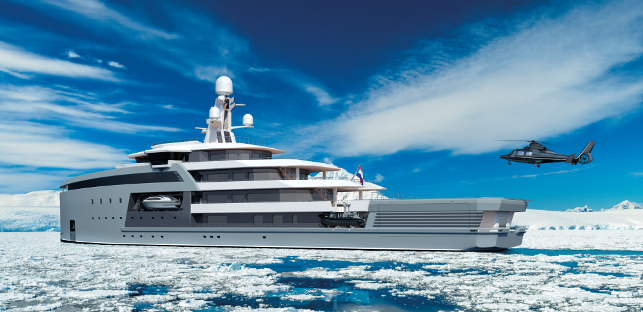
SeaXplorer
“The new generation of owners want more from their yachts”, states Tim Soper, as he opens his laptop at the table of a grand restaurant on London’s ritzy Jermyn Street.
It’s a fittingly moneyed venue in which to be discussing SeaXplorer, a new superyacht that can travel to the furthest corners of the globe.
A buyer could spend upwards of £100 million on one of the vessels, and given the luxurious access it could give to incredible scenes such as those on his screen, it’s easy to see why.
“They don’t want just a party palace that sits in the Med and the Caribbean. They want to be able to go wherever they want,” he says, scrolling through pictures of a party within touching distance of a pod of whales.
Soper is founding partner of EYOS Expeditions. Having worked in adventurous activities like deep sea diving around the world from a young age, he is one of the most skilled expedition leaders in the travel industry.
His clients, he says, are this new generation of yacht owners, mostly those who have made their own money, still young enough to be very active and who want to go out and have amazing experiences.
“The yacht isn’t necessarily about having a big thing to show off. It’s about having a platform to go and see the world on your own terms,” he says.
“We have people who want to be able to go and kiteboard off the most remote islands in the Pacific, and they don’t want to be told, ‘Oh, we don’t have the fuel range to get there’. And when you get there, it will be too rough to lower the tenders. It’s about giving that capability.”
SeaXplorer is a yacht designed exactly for that purpose. A combination of Dutch commercial shipping giant Damen’s engineering expertise, its sister company Amels’ no-compromise luxury yacht know-how, exterior styling by award-winning yacht design studio Azure, and the expeditions experience of EYOS, the boat is honed for a lifetime of luxury voyages.
Life at sea

Participants in an EYOS expedition admire local wildlife
The new generation of owners are looking to fit more ‘toys’ on board: submarines, multiple tenders (smaller craft that can be dropped into the water) and jet skis – but most yachts haven’t the necessary space for everything.
In response to this, Damen launched a range of support vessels specifically to store and transport all this equipment. However, owners started to make requests for added living space on the support boats – transforming them into yachts for fun and excitement, rather than dinner parties and cocktails.
This, coupled with the rise in demand of expedition capable yachts, gave birth to the concept of SeaXplorer – a luxurious yet functional storage-heavy yacht, capable of travelling wherever the owner wanted.
Overseeing the entire process, Damen’s design philosophy stands at odds with that of most yacht designers.
While many will take a single customer’s demands and create a one-off boat, Damen’s design team instead studied the wider market to develop a product series. “We’re effectively building on speculation without having a client,” says Jaap van der Velde, design manager of SeaXplorer.
“So the moment that the clients come in, the complete engineering specification is done and we’ve already began constructing the boat, so there’s a very short delivery time, which impacts the moment the client can receive the ship.”
In the commercial industry, this is key for owners wanting to start earning on their investment as quickly as possible, but for individual yacht clients, it has benefits too.
SeaXplorer will be a purpose-built series, coming in three sizes – 65, 90 and 100 metres long – and this has the advantage that its base engineering will only need to be completed once, helping keep costs, errors and time to build to a minimum.
The same rule applies to the building process, where the designers and manufacturing staff involved learn from the previous build and can then include improvements to the next.
“You have to know your market. It’s more complex to build a series boat than a custom-build boat, because customers [need to be] attracted to a series boat design,” explains van der Velde, emphasising that for this, the importance lies in “the power of the starting point”.
Practicalities at the poles
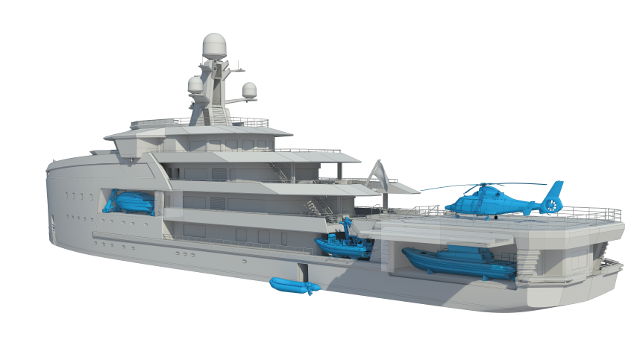
Accommodating different types of support vessels was crucial to SeaXplorer’s design
The starting point for SeaXplorer came from EYOS’ knowledge of organising and managing expeditions on existing boats.
Tim Soper was able to give input as to what was needed for navigating in different regions and what was required in terms of facilities on board, as well as observations around improving the adventuring experience of passengers.
“The design meetings were a dream for us, because we are continually frustrated by working with yachts that don’t have the capabilities that we need,” says Soper.
He gives the example of yacht owners wanting to navigate the Northwest Passage – a sea route connecting the northern Atlantic and Pacific Oceans through the Arctic Ocean – but finding that their yachts are not designed for difficult tasks such as navigating ice flows.
Passing through ice can heavily damage a yacht’s stabilisers under the water, a scenario best avoided in such remote circumstances. As a result, SeaXplorer has retractable stabilisers, as well as an ice-breaking stern to move through ice nearly a metre thick.
The yacht’s two propulsive units turn around 360 degrees, and its rounded rear slowly reverses its way through.
Damen’s proprietary Sea Axe bow at the front allows ships to smoothly slice through waves when travelling in more navigable waters.
Design for expeditions also requires the practical use of space. The largest model needs to be able to support 30 guests and 50 crew members for 40 days, so storerooms big enough to hold enough fresh supplies without reprovisioning become hugely important.
Helicopters pose another storage challenge, with every superyacht owner expecting a H-stamped landing pad on one of the decks. Traditionally, everywhere that superyachts go, there are places for helicopters to land and refuel ashore.
Onboard hangars become necessary once the yacht is too far away from shore to fly, and the shelter provided helps store fuel and protect the helicopter from the rough seas.
“It’s about building in those types of capabilities, and also about the guest experience: how they connect with the outside world,” says Soper.
“Yacht design is typically about luxury – making things swish. We wanted glass. You’re going to these destinations to see the natural world outside. You don’t want to be closed in.”
The most interesting places to be on an expedition yacht is the bridge or bow as they’re where everything is happening – spotting whales coming by, or looking over the rail to see the axe-shaped bow parting the icy sea.
On SeaXplorer, the bow is a feature, with an observation lounge behind it and the mooring deck below to let the passengers enjoy the space.
The bridge was positioned to allow officers a clear enough view to navigate the waters, but also made extra large, so passengers can go up and sit and chat with the crew, rather than segregating the space.
There’s still separation between the technical areas and what Soper terms ‘the hotel side’, but it’s about all having an experience together, with the captain and crew important to that. “You want to be up there hanging out with the captain, him saying, ‘Look over there’, and you’re seeing seals and penguins and whales.”
SeaXplorer excels at getting its occupants as close to nature as quickly as possible.
As an expedition leader, Soper has often been frustrated by the time it takes a traditional yacht to stop and anchor.
SeaXplorer has special Davit cranes fitted that allow the yacht to launch a fast rigid-inflatable boat over the side while still moving, making use of Damen’s expertise in military patrol vessels, where the system is used to intercept drug smugglers.
Typically, these cranes won’t feature on a luxury yacht, as they jar against the smooth exterior lines.
“This was a really important feature,” explains Soper of the decision. “If you want to have the experience of getting out on the water, alongside Humpback whales, that’s what you need to do – get out there quickly.”
Home conforts
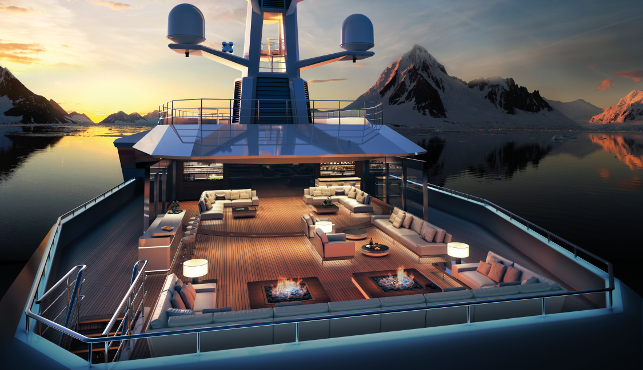
Despite its practical design, SeaXplorer is also big on luxury and comfort
Life on board an expedition yacht is different from any other kind of superyacht experience. A lengthy voyage to the Arctic may involve being cooped-up on board for weeks.
“It’s a much more intense experience that puts pressure on the interior spaces of the yacht from a design point of view,” says Soper. As a result, providing enough space for people to hang out and find some quiet is a priority.
Add provisions and fuel storage, along with room for wastewater (important to the new environmental Polar Code, which will be enforced from 2017) and space becomes an even more critical factor.
Despite this, the yacht offers luxury comfort in the cabins, as well as a mess hall, hospital, gym and internet café.
“It’s the best of both worlds, there’s no compromise on the interior in the finish, because you’ve got the Amels influence of the very high-quality workmanship and design,” points out Soper, “but you’re not wasting money on things you don’t need.”
For the price of a superyacht of the same length, he argues that SeaXplorer comes with the bonus of having many more capabilities.
“She’ll be fine parked up in Monaco – she’ll still look lovely! But the point is that you can then get on board in Monaco and say, ‘I’m going to go up to the Arctic and see polar bears in ten days’, and you don’t need to stop for fuel on the way.”
Back at the shipyard
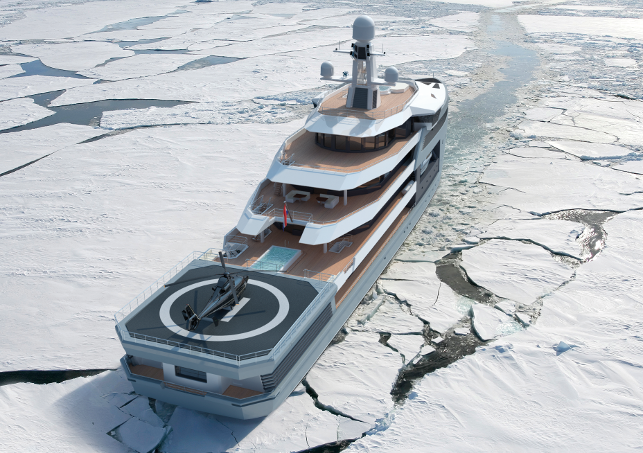
SeaXplorer has retractable stabilisers and an ice-breaking stern to allow it to move through thick ice
Accommodating the requests of Davit cranes, large tender storage areas and helicopter hangars, Damen set about the design in much the same as it would for any other craft.
According to Jaap van der Velde, the design process at Damen is split into three stages – first is the aesthetics design stage. Azure produces hand-drawn sketches, reviewed by the Damen team. Once approved, they’re translated into a full 3D model in Rhino.
The second phase takes place in a 2D environment, which includes the construction, mechanical engineering, naval architecture and interior layout, all done in AutoCAD.
The move towards full 3D CAD is slow. At Amels, Siemens NX is used to model the entire yacht in 3D.
It’s only once the results of the design phase and the engineering phase match that a concurrent engineering phase is possible, van der Velde explains.
“In the third phase, we start with the engineering to create product information for all the piping and steelcutting,” he explains. Damen entrusts its design to Cadmatic, a naval modelling and engineering software it has used since the 1980s. Users work in a 2D planning environment for the engineering work, with a 3D viewer.
It’s a programme that has proven itself on very complex ship types for decades, he says.
“We get a lot of data from our suppliers, but we always have problems with the data,” chuckles van der Velde.
“Most of the time there’s too much detail, so a model of an engine might be a 2GB file. If you have a couple of these engines in your CAD model, and other equipment, then your model will explode completely!”
To get past this problem, the engineering team remodel the parts to reduce the complexity and file size, leaving them with the right dimensions and connections to accurately include them in the model.
A lot of simulation is carried out. Some is computer-based, such as Computational Fluid Dynamics (CFD) optimisation of Finite Element Method (FEM) analyses, but physical-scale model tests are used, too.
At the Hamburg ship-testing basin, a model of the SeaXplorer, CNC machined to scale, including its propellers, was placed into a giant ice-testing basin, in which ice size and consistency is also created to scale. From this testing, performance data was collected and applied to the design.
Envious glances
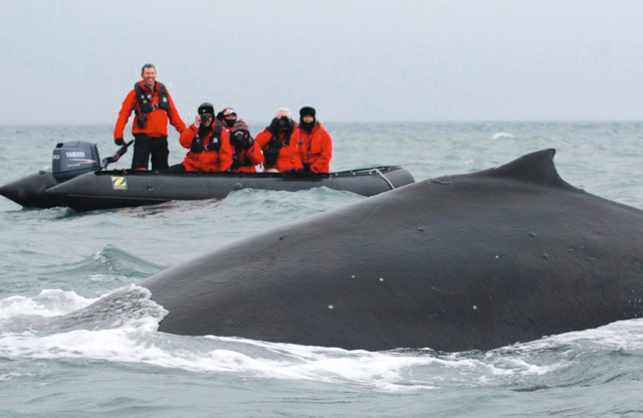
Tim Soper and his party getting up close and personal with a whale
Back at our restaurant table in London, diners on surrounding tables continue to glance over at the SeaXplorer visuals.
Their interest seems promising: now Damen has invested in bringing the craft to market, it needs to secure buyers.
Having launched the design at the Monaco Yacht Show at the end of last year, its visualisations were key to showcasing its unique ability in the ice. However, Damen is now investigating the use of on-board virtual reality (VR) experiences.
Expected to be a marketing staple in the next five years, VR increases the need for 3D assets and, as a result, Damen may need to adopt different 3D CAD tools.
Yet Soper has another method to win over potential buyers – the use of jaw-dropping drone footage, showing him leading a yacht party in activities such as walking on icebergs and sitting in boats alongside pods of whales.
The thought of exploring this environment in such luxury has already sold the SeaXplorer experience to us and the rest of the diners in the room.
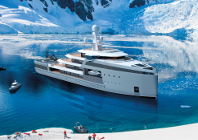
The SeaXplorer super yacht, designed for a lifetime of luxury adventures
Default

